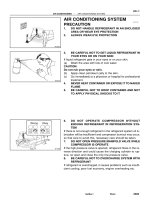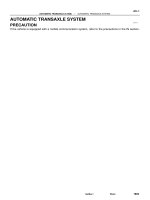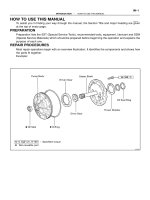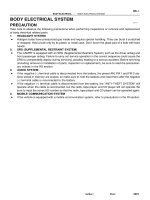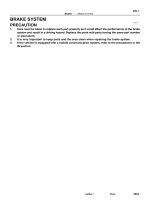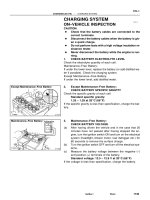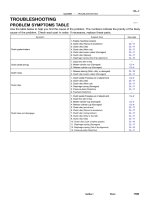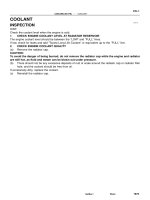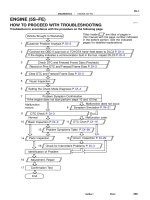Camry Repair Manual DIAGNOSTICS
Bạn đang xem bản rút gọn của tài liệu. Xem và tải ngay bản đầy đủ của tài liệu tại đây (6.86 MB, 1,304 trang )
DI00F–08
Vehicle Brought to Workshop
Customer Problem Analysis P. DI–2
Problem Symptom Confirmation
If the engine does not start perform steps 10 and 12 first
Connect the OBD II scan tool or TOYOTA hand–held tester to DLC3 P. DI–3
If the display indicates a communication fault in the tool, inspect DLC3 P. DI–3
Check DTC and Freezed Frame Data (Precheck)
Record or Print DTC and Freezed Frame Data P. DI–3
Clear DTC and Freezed Frame Data P. DI–3
Visual Inspection
Setting the Check Mode Diagnosis P. DI–3
Symptom Simulation P. IN–21
Basic Inspection P. DI–3
DTC Chart P. DI–16
Problem Symptoms Table P. DI–28
Circuit Inspection P. DI–29
Adjustment, Repair
DTC Check P. DI–3
Titles inside are titles of pages in
in the bottom portion. See the indicated
pages for detailed explanations.
this manual with the page number indicated
Malfunction
occurs.
Malfunction does not occur.
Parts Inspection
Check for Intermittent Problems P. DI–3
Identification of Problem
Confirmation Test
End
1
2
3
4
5
6
7
10
8
9
11
12
13
15
14
16
Normal Malfunction code.
17
–DIAGNOSTICS ENGINE (5S–FE)
DI–1
236AuthorĂ: DateĂ:
ENGINE (5S–FE)
HOW TO PROCEED WITH TROUBLESHOOTING
Troubleshoot in accordance with the procedure on the following page.
DI00G–05
ENGINE CONTROL SYSTEM Check Sheet
Customer’s Name
Driver’s Name
Data Vehicle
Brought in
License No.
Model and Model
Year
Frame No.
Engine Model
Odometer Reading
Problem Symptoms
Engine does
not Start
Difficult to
Start
Poor Idling
Poor
Driveaability
Engine Stall
Others
Engine does not crank No initial combustion No complete combustion
Engine cranks slowly
Other
Incorrect first idle Idling rpm is abnormal High ( rpm) Low ( rpm)
Rough idling Other
Hesitation Back fire Muffler explosion (after–fire) Surging
Knocking Other
Soon after starting After accelerator pedal depressed
After accelerator pedal released During A/C operation
Shifting from N to D Other
Datas Problem
Occurred
Problem Frequency
Condition When
Problem Occurs
Weather
Engine Operation
Engine Temperature
Place
Outdoor
Temperature
Constant Sometimes ( times per day/month) Once only
Other
Fine Cloudy Rainy Snowy Various/Other
Hot Warm Cool Cold (approx. °F/ °C)
Highway Suburbs Inner city Uphill Downhill
Rough road Other
Cold Warming up After warming up
Any temperature
Other
Starting Just after starting ( min.) Idling Racing
Driving Constant speed Acceleration Deceleration
A/C switch ON/OFF Other
Condition of MIL Remains on Sometimes light up Does not light up
Normal Malfunction code(s) (code )
Freezed frame data ( )
Normal Malfunction code(s) (code )
Freezed frame data ( )
Normal Mode
(Precheck)
Check Mode
DTC Inspection
Inspector’s
Name
km
miles
DI–2
–DIAGNOSTICS ENGINE (5S–FE)
237AuthorĂ: DateĂ:
CUSTOMER PROBLEM ANALYSIS CHECK
DI00H–08
FI0534
S05331
TOYOTA Hand–Held Tester
DLC3
–DIAGNOSTICS ENGINE (5S–FE)
DI–3
238AuthorĂ: DateĂ:
PRE–CHECK
1. DIAGNOSIS SYSTEM
(a) Description
D When troubleshooting OBD II vehicles, the only dif-
ference from the usual troubleshooting procedure
is that you connect to the vehicle the OBD II scan
tool complying with SAE J1978 or TOYOTA hand–
held tester, and read off various data output from
the vehicle’s ECM.
D OBD II regulations require that the vehicle’s on–
board computer lights up the Malfunction Indicator
Lamp (MIL) on the instrument panel when the com-
puter detects a malfunction in the emission control
system / components or in the powertrain control
components which affect vehicle emissions, or a
malfunction in the computer. In addition to the MIL
lighting up when a malfunction is detected, the ap-
plicable Diagnostic Trouble Code (DTC) prescribed
by SAE J2012 are recorded in the ECM memory.
(See page DI–16)
If the malfunction does not reoccur in 3 consecutive trips, the
MIL goes off automarially but the DTCs remain recorded in the
ECM memory.
D To check the DTCs, connect the OBD II scan tool or
TOYOTA hand–held tester to Data Link Connector
3 (DLC3) on the vehicle. The OBD II scan tool or
TOYOTA hand–held tester also enables you to
erase the DTCs and check freezed frame data and
various forms of engine data (For operating instruc-
tions, see the OBD II scan tool’s instruction book.)
DTCs include SAE controlled codes and manufac-
turer controlled codes. SAE controlled codes must
be set as prescribed by the SAE, while manufactur-
er controlled codes can be set freely by the
manufacturer within the prescribed limits. (See DTC
chart on page DI–16)
DI–4
–DIAGNOSTICS ENGINE (5S–FE)
239AuthorĂ: DateĂ:
D The diagnosis system operates in normal mode
during normal vehicle use. It also has a check mode
for technicians to simulate malfunction symptoms
and troubleshoot. Most DTCs use 2 trip detection
logic* to prevent erroneous detection, and ensure
thorough malfunction detection. By switching the
ECM to check mode when troubleshooting, the
technician can cause the MIL to light up for a mal-
function that is only detected once or momentarily.
(TOYOTA hand–held tester only)
(See page DI–3)
D *2 trip detection logic: When a malfunction is first
detected, the malfunction is temporarily stored in
the ECM memory.(1st trip)
If the same malfunction is detected again during the second
drive test, this second detection causes the MIL to light up.(2nd
trip) (However, the IG switch must be turned OFF between the
1st trip and the 2nd trip.)
D Freeze frame data:
Freeze frame data records the engine condition
when a misfire (DTCs P0300 ∼ P0304) or fuel trim
malfunction (DTCs P0171, P0172) or other mal-
function (first malfunction only), is detected.
Because freeze frame data records the engine
conditions (fuel system, calculated load, engine
coolant temperature, fuel trim, engine speed, ve-
hicle speed, etc.) when the malfunction is detected,
when troubleshooting it is useful for determining
whether the vehicle was running or stopped, the en-
gine warmed up or not, the air–fuel ratio lean or rich,
etc. at the time of the malfunction.
D Priorities for troubleshooting:
If troubleshooting priorities for multiple DTCs are given in the
applicable DTC chart, these should be followed.
If no instructions are given troubleshoot DTCs according to the
following priorities.
(1) DTCs other than fuel trim malfunction (DTCs
P0171, P0172), EGR (DTCs P0401, P0402), and
misfire (DTCs P0300 ∼ P0304).
(2) Fuel trim malfunction (DTCs P0171, P0172), and
EGR (DTCs P0401, P0402).
(3) Misfire (DTCs P0300 ∼ P0304).
N09214
S05347
–DIAGNOSTICS ENGINE (5S–FE)
DI–5
240AuthorĂ: DateĂ:
(b) Check the DLC3
The vehicle’s ECM uses ISO 9141–2 for communication.
The terminal arrangement of DLC3 complies with SAE
J1962 and matches the ISO 9141–2 format.
Terminal No. Connection / Voltage or Resistance Condition
7 Bus ę Line / Pulse generation During transmission
4 Chassis Ground ↔ Body Ground /1 Ω or less Always
5 Signal Ground ↔ Body Ground /1 Ω or less Always
16 Battery Positive ↔ Body Ground /9 ∼ 14 V Always
HINT:
If your display shows ”UNABLE TO CONNECT TO VEHICLE”
when you have connected the cable of the OBD II scan tool or
TOYOTA hand–held tester to DLC3, turned the ignition switch
ON and operated the scan tool, there is a problem on the ve-
hicle side or tool side.
D If communication is normal when the tool is connected to
another vehicle, inspect DLC3 on the original vehicle.
D If communication is still not possible when the tool is con-
nected to another vehicle, the problem is probably in the
tool itself, so consult the Service Department listed in the
tool’s instruction manual.
2. INSPECT DIAGNOSIS (Normal Mode)
(a) Check the MIL.
(1) The MIL comes on when the ignition switch is turned
ON and the engine is not running.
HINT:
If the MIL does not light up, troubleshoot the combination meter
(See page BE–2).
(2) When the engine started, the MIL should go off. If
the lamp remains on, the diagnosis system has de-
tected a malfunction or abnormality in the system.
(b) Check the DTC.
NOTICE:
TOYOTA hand–held tester only: When the diagnosis sys-
tem is switched from normal mode to check mode, it
erases all DTCs and freezed frame data recorded in normal
mode. So before switching modes, always check the DTCs
and freezed frame data, and note them down.
(1) Prepare the OBD II scan tool (complying with SAE
J1978) or TOYOTA hand–held tester.
DI–6
–DIAGNOSTICS ENGINE (5S–FE)
241AuthorĂ: DateĂ:
(2) Connect the OBD II scan tool or TOYOTA hand–
held tester to DLC3 under the instrument panel low-
er pad.
(3) Turn the ignition switch ON and turn the OBD II scan
tool or TOYOTA hand–held tester switch ON.
(4) Use the OBD II scan tool or TOYOTA hand–held
tester to check the DTCs and freezed frame data
and note them down. (For operating instructions,
see the OBD II scan tool’s instruction book.)
(5) See page DI–3 to confirm the details of the DTCs.
NOTICE:
D When simulating symptoms with an OBD II scan tool
(excluding TOYOTA hand–held tester) to check the
DTCs, use normal mode. For code on the DTC chart
subject to ”2 trip detection logic”, perform the follow-
ing either action.
D Turn the ignition switch OFF after the symptom is
simulated the first time. Then repeat the simulation
process again. When the problem has been simulated
twice, the MIL lights up and the DTCs are recorded in
the ECM.
D Check the 1st trip DTC using Mode 7 (Continuous Test
Results) for SAE J1979.
(c) Clear the DTC.
The DTCs and freezed frame data will be erased by either
action.
(1) Operating the OBD II scan tool (complying with SAE
J1978) or TOYOTA hand–held tester to erase the
codes. (See the OBD II scan tool’s instruction book
for operating instructions.)
(2) Disconnecting the battery terminals or EFI fuse.
NOTICE:
If the TOYOTA hand–held tester switches the ECM from
normal mode to check mode or vice–versa, or if the ignition
switch is turned from ON to ACC or OFF during check
mode, the DTCs and freezed frame data will be erased.
FI3605
ON
OFF
Flashing
0.13 Second
–DIAGNOSTICS ENGINE (5S–FE)
DI–7
242AuthorĂ: DateĂ:
3. INSPECT DIAGNOSIS (Check Mode)
HINT:
TOYOTA hand–held tester only:
Compared to the normal mode, the check mode has an in-
creased sensitivity to detect malfunctions.
Furthermore, the same diagnostic items which are detected in
the normal mode can also be detected in the check mode.
(a) Check the DTC.
(1) Initial conditions
D Battery positive voltage 11 V or more
D Throttle valve fully closed
D Transmission in P or N position
D Air conditioning switched OFF
(2) Turn ignition switch OFF.
(3) Prepare the TOYOTA hand–held tester.
(4) Connect the TOYOTA hand–held tester to the
DLC3 under the instrument panel lower pad.
(5) Turn the ignition switch ON and switch the TOYOTA
hand–held tester ON.
(6) Switch the TOYOTA hand–held tester normal mode
to check mode. (Check that the MIL flashes.)
NOTICE:
If the TOYOTA hand–held tester switches the ECM from
normal mode to check mode or vice–versa, or if the igni-
tion switch is turned from ON to ACC or LOCK during check
mode, the DTCs and freezed frame data will be erased.
(7) Start the engine. (The MIL goes out after the engine
start.)
(8) Simulate the conditions of the malfunction de-
scribed by the customer.
NOTICE:
Leave the ignition switch ON until you have checked the
DTC, etc.
(9) After simulating the malfunction conditions, use the
TOYOTA hand–held tester diagnosis selector to
check the DTCs and freezed frame data, etc.
HINT:
Take care not to turn the ignition switch OFF. Turning the ignition
switch OFF switches the diagnosis system from check mode to
normal mode. So all DTCs, etc. are erased.
(10) After checking the DTC, inspect the applicable cir-
cuit.
DI–8
–DIAGNOSTICS ENGINE (5S–FE)
243AuthorĂ: DateĂ:
4. FAIL–SAFE CHART
If any of the following codes is recorded, the ECM enters fail–safe mode.
DTC No. Fail–Safe Operation Fail–Safe Deactivation Conditions
P0105 Ignition timing fixed at 5° BTDC Returned to normal condition
P0110 Intake air temperature is fixed at 20°C (68°F) Returned to normal condition
P0115 Engine coolant temperature is fixed at 80°(176°F) Returned to normal condition
P0120 VTA is fixed at 0°
The following condition must be repeated at least 2 times
consecutively
VTA y 0.1 V and u 0.95 V
P0135
P0141
The heater circuit in witch an abnormality is detected is
turned off
Ignition switch OFF
P0325 Max. timing retardation Ignition switch OFF
P0336 Fuel cut Returned to normal condition
P1135
The heater circuit in which an abnormality is detected is
turned off
Ignition switch OFF
P1300
P1310
Fuel cut IGF signal is detected for 2 consecutive ignitions
5. CHECK FOR INTERMITTENT PROBLEMS
TOYOTA HAND–HELD TESTER only:
By putting the vehicle’s ECM in check mode, 1 trip detection logic is possible instead of 2 trip detection logic
and sensitivity to detect open circuits is increased. This makes it easier to detect intermittent problems.
(1) Clear the DTC (See page DI–3).
(2) Set the check mode (See page DI–3).
(3) Perform a simulation test (See page IN–21).
(4) Check the connector and terminal (See page IN–31).
(5) Handle the connector (See page IN–31).
6. BASIC INSPECTION
When the malfunction code is not confirmed in the DTC check, troubleshooting should be performed in the
order for all possible circuits to be considered as the causes of the problems. In many cases, by carrying
out the basic engine check shown in the following flow chart, the location causing the problem can be found
quickly and efficiently. Therefore, use of this check is essential in engine troubleshooting.
1 Is battery positive voltage 11 V or more when engine is stopped?
NO Charge or replace battery.
YES
P00495
Outside
Inside
–DIAGNOSTICS ENGINE (5S–FE)
DI–9
244AuthorĂ: DateĂ:
2 Is engine cranked?
NO Proceed to page ST–2 and continue to
troubleshoot.
YES
3 Does engine start?
NO Go to step 7.
YES
4 Check air filter.
PREPARATION:
Remove the air filter.
CHECK:
Visually check that the air filter is not dirty or excessive oily.
HINT:
If necessary, clean the filter with compressed air. First blow from
inside thoroughly, then blow from outside of the filter.
NG Repair or replace.
OK
DI–10
–DIAGNOSTICS ENGINE (5S–FE)
245AuthorĂ: DateĂ:
5 Check idle speed.
PREPARATION:
(a) Warm up the engine to normal operating temperature.
(b) Switch off all the accessories.
(c) Switch off the air conditioning.
(d) Shift the transmission into the N position.
(e) Connect the OBD II scan tool or TOYOTA hand–held tester to DLC3 on the vehicle.
CHECK:
Use the CURRENT DATA to check the idle speed.
OK:
Idle speed: 650 ∼ 750 rpm
NG Proceed to problem symptoms table on
page DI–28.
OK
A07370
S05309
A07664
E1TE1
SST
DLC1
–DIAGNOSTICS ENGINE (5S–FE)
DI–11
246AuthorĂ: DateĂ:
6 Check ignition timing.
PREPARATION:
(a) Warm up the engine to normal operating temperature.
(b) Shift the transmission into the N position.
(c) Keep the engine speed at idle.
(d) Using SST, connect terminals TE1 and E1 of the DLC1.
SST 09843–18020
(e) Using a timing light, connect the tester to the No.1 high–
tension cord.
CHECK:
Check the ignition timing.
OK:
Ignition timing: 10° BTDC at idle
NG Proceed to page IG–1 and continue to trouble-
shoot.
OK
Proceed to problem symptoms table on page
DI–28.
S05327
Fuel Inlet Hose
DI–12
–DIAGNOSTICS ENGINE (5S–FE)
247AuthorĂ: DateĂ:
7 Check fuel pressure.
PREPARATION:
(a) Be sure that enough fuel is in the tank.
(b) Connect the TOYOTA hand–held tester to the DLC3.
(c) Turn the ignition switch ON and push TOYOTA hand–held
tester main switch ON.
(d) Use the ACTIVE TEST mode to operate the fuel pump.
(e) Please refer to the TOYOTA hand–held tester operator’s
manual for further details.
(f) If you have no TOYOTA hand–held tester, connect the
positive (+) and negative (–) leads from the battery to the
fuel pump connector (See page SF–6).
CHECK:
Check for fuel pressure in the fuel inlet hose when it is pinched
off.
HINT:
At this time, you will hear a fuel flowing noise.
NG Proceed to page SF–6 and continue to trouble-
shoot.
OK
A00359
–DIAGNOSTICS ENGINE (5S–FE)
DI–13
248AuthorĂ: DateĂ:
8 Check for spark.
PREPARATION:
(a) Disconnect the high–tension cord from the spark plug.
(b) Remove the spark plug.
(c) Install the spark plug to the high–tension cord.
(d) Disconnect the injector connector.
(e) Ground the spark plug.
CHECK:
Check if spark occurs while the engine is being cranked.
NOTICE:
To prevent excess fuel being injected from the injectors
during this test, don’t crank the engine for more than 5 ∼ 10
seconds at a time.
NG Proceed to page IG–1 and continue to trouble-
shoot.
OK
Proceed to problem symptoms table on page
DI–28.
DI–14
–DIAGNOSTICS ENGINE (5S–FE)
249AuthorĂ: DateĂ:
7. ENGINE OPERATING CONDITION
NOTICE:
The values given below for ”Normal Condition” are representative values, so a vehicle may still be
normal even if its value varies from those listed here. So do not decide whether a part is faulty or
not solely according to the ”Normal Condition” here.
(a) CARB mandated signals.
TOYOTA hand–held tester display Measurement Item Normal Condition*1
FUEL SYS #1
Fuel System Bank 1
OPEN: Air–fuel ratio feedback stopped
CLOSED: Air–fuel ratio feedback operating
Idling after warming up: CLOSED
CALC LOAD
Calculator Load:
Current intake air volume as a proportion of max.
intake air volume
Idling: 19.7 ∼ 50.4 %
Racing without load (2,500rpm): 16.8 ∼ 47.4 %
COOLANT TEMP. Engine Coolant Temp. Sensor Value After warming up: 80 ∼ 95°C (176 ∼ 203°F)
SHORT FT #1 Short–term Fuel Trim Bank 1 0 ± 20 %
LONG FT #1 Long–term Fuel Trim Bank 1 0 ± 20 %
ENGINE SPD Engine Speed Idling: 650 ∼ 750 rpm
VEHICLE SPD Vehicle Speed Vehicle Stopped: 0 km/h (0 mph)
IGN ADVANCE
Ignition Advance:
Ignition Timing of Cylinder No. 1
Idling: BTDC 0 ∼ 10°
INTAKE AIR Intake Air Temp. Sensor Value Equivalent to Ambient Temp.
MAP Absolute Pressure inside Intake Manifold
Idling: 20 ∼ 51 kPa
Racing without load (2,500 rpm):
17 ∼ 48 kPa
THROTTLE POS
Voltage Output of Throttle Position Sensor
Calculated as a percentage:
0 V → 0%, 5 V → 100 %
Throttle Fully Closed: 6 ∼ 16 %
Throttle Fully Open: 64 ∼ 98 %
O2S B1, S1
Voltage Output of Heated Oxygen Sensor
Bank 1 Sensor 1
Idling: 0.1 ∼ 0.9 V (0.56 ∼ 0.76 V *2)
O2FT B1, S1
Heated Oxygen Sensor Fuel Trim Bank 1
Sensor 1
(Same as SHORT FT #1)
0 ± 20 %
A/FS B1, S1 *3 Voltage Output of A/F Sensor Idling: 2.8 ∼ 3.8 V
A/FFT B1, S1 *3 A/F Sensor Fuel Trim (Same as SHORT FT #1) 0 ± 20 %
O2S B1, S2
Voltage Output of Heated Oxygen Sensor
Bank 1 Sensor 2
Driving at 50 km/h (31 mph): 0.05 ∼ 0.95 V
*1: If no conditions are specifically stated for ”ldling”, it means the shift lever is at N or P position, the A/C
switch is OFF and all accessory switches are OFF.
*2: Only for California Specification vehicles, when you use the OBD II scan tool (excluding TOYOTA hand–
held tester).
*3: Only for California Specification vehicles, when you use the TOYOTA hand–held tester.
–DIAGNOSTICS ENGINE (5S–FE)
DI–15
250AuthorĂ: DateĂ:
(b) TOYOTA Enhanced Signals.
TOYOTA hand–held tester display Measurement Item Normal Condition*1
MISFIRE RPM Engine RPM for first misfire range Misfire 0: 0 rpm
MISFIRE LOAD Engine load for first misfire range Misfire 0: 0 g/r
INJECTOR Fuel injection time for cylinder No.1 Idling: 2.9 ∼ 5.1 ms
IAC DUTY RATIO
Intake Air Control Valve Duty Ratio
Opening ratio rotary solenoid type IAC valve
Idling: 25 ∼ 62 %
STARTER SIG Starter Signal Cranking: ON
CTP SIG Closed Throttle Position Signal Throttle fully closed: ON
A/C SIG A/C Switch Signal A/C ON: ON
PNP SIG Park/Neutral Position Switch Signal P or N position: ON
ELECTCL LOAD SIG Electrical Load Signal Defogger S/W ON: ON
STOP LIGHT SW Stop Light Switch Signal Stop light switch ON: ON
PS OIL PRESS SW Power Steering Oil Pressure Switch Signal Turn steering wheel: ON
FC IDL
Fuel Cut Idle: Fuel cut when throttle valve fully
closed, during deceleration
Fuel cut operating: ON
FC TAU Fuel Cut TAU: Fuel cut during very light load Fuel cut operating: ON
CYL#1, CYL#2, CYL#3, CYL#4 Abnormal revolution variation for each cylinder 0 %
IGNITION
Total number of ignition for every 1,000 revolu-
tions
0 ∼ 2,000 rpm
EGR SYSTEM EGR system operating condition Idling: OFF
FUEL PUMP Fuel Pump Signal Idling: ON
A/C CUT SIG A/C Cut Signal A/C S/W OFF: ON
A/C MAG CLUTCH A/C Switch Signal A/C ON: ON
EVAP (PURGE) VSV EVAP VSV Signal VSV operating: Avove 30 %
VAPOR PRESS VSV Vapor Pressure VSV Signal VSV operating: ON
TOTAL FT B1
Total Fuel Trim Bank 1: Average value for fuel
trim system of bank 1
Idling: 0.8 ∼ 1.2 V
O2 LR B1, S1 *2
Heated Oxygen Sensor Lean Rich Bank 1 Sen-
sor 1: Response time for oxygen sensor output to
switch from lean to rich
Idling after warming up: 0 ∼ 1,000 msec.
O2 RL B1, S1 *2
Heated Oxygen Sensor Rich Lean Bank 1 Sen-
sor 1: Response time for oxygen sensor output to
switch from rich to lean
Idling after warming up: 0 ∼ 1,000 msec.
*1: If no conditions are specifically stated for ”ldling”, it means the shift lever is at N or P position, the A/C
switch is OFF and all accessory switches are OFF.
*2: Except California Specification vehicles.
DI00I–09
DI–16
–DIAGNOSTICS ENGINE (5S–FE)
251AuthorĂ: DateĂ:
DIAGNOSTIC TROUBLE CODE CHART
HINT:
Parameters listed in the chart may not be exactly the same as your reading due to the type of instrument
or other factors.
If a malfunction code is displayed during the DTC check in check mode, check the circuit for that code listed
in the table below. For details of each code, turn to the page referred to under the ’’See Page ’’ for the respec-
tive ’’DTC No.’’ in the DTC chart.
SAE Controlled:
DTC No.
(See Page)
Detection Item Trouble Area MIL*
1
Memory
P0105
(DI–29)
Manifold Absolute
Pressure/Barometric
Pressure Circuit
Malfunction
j Open or short in manifold absolute pressure sensor circuit
j Manifold absolute pressure sensor
j ECM
f f
P0106
(DI–33)
Manifold Absolute Pressure
Circuit Range/Performance
Problem
j Manifold absolute pressure sensor
j Vacuum line
f f
P0110
(DI–35)
Intake Air Temp. Circuit
Malfunction
j Open or short in intake air temp. sensor circuit
j Intake air temp. sensor (built into mass air flow meter)
j ECM
f f
P0115
(DI–41)
Engine Coolant Temp. Circuit
Malfunction
j Open or short in engine coolant temp. sensor circuit
j Engine coolant temp. sensor
j ECM
f f
P0116
(DI–47)
Engine Coolant Temp. Circuit
Range/Performance Problem
j Engine coolant temp. sensor
j Cooling system
f f
P0120
(DI–49)
Throttle/Pedal Position
Sensor/Switch ”A” Circuit
Malfunction
j Open or short in throttle position sensor circuit
j Throttle position sensor
j ECM
f f
P0121
(DI–54)
Throttle/Pedal Position
Sensor/Switch ”A” Circuit
Range/Performance Problem
j Throttle position sensor f f
*
2
P0125
(DI–61)
Insufficient Coolant Temp. for
Closed Loop Fuel Control
(Except California Spec.)
j Open or short in heated oxygen sensor (bank 1 sensor 1)
circuit
j Heated oxygen sensor (bank 1 sensor 1)
j ECM
f f
*
3
P0125
(DI–55)
Insufficient Coolant Temp. for
Closed Loop Fuel Control
(Only for California Spec.)
j Open or short in A/F sensor circuit
j A/F sensor
j ECM
f f
*
2
P0130
(DI–66)
Heated Oxygen Sensor Circuit
Malfunction (Bank 1 Sensor 1)
j Heated oxygen sensor
j Fuel trim malfunction
f f
*
2
P0133
(DI–71)
Heated Oxygen Sensor Circuit
Slow Response
(Bank 1 Sensor 1)
j Heated oxygen sensor
j Fuel trim malfunction
f f
*
2
P0135
(DI–75)
Heated Oxygen Sensor Heater
Circuit Malfunction
(Bank 1 Sensor 1)
j Open or short in heater circuit of heated oxygen sensor
j Heated oxygen sensor heater
j ECM
f f
*
1
: f XXX MIL lights up
*
2
: Except California specification vehicles
*
3
: Only for California specification vehicles
–DIAGNOSTICS ENGINE (5S–FE)
DI–17
252AuthorĂ: DateĂ:
DTC No.
(See Page)
Detection Item Trouble Area MIL*
1
Memory
P0136
(DI–77)
Heated Oxygen Sensor Circuit
Malfunction
(Bank 1 Sensor 2)
j Heated oxygen sensor f f
P0141
(DI–75)
Heated Oxygen Sensor Heater
Circuit Malfunction
(Bank 1 Sensor 2)
j Same as DTC P0135 f f
*
3
P0171
(DI–84)
System too Lean
(Fuel Trim)
(Except California Spec.)
j Air intake (hose loose)
j Fuel line pressure
j Injector blockage
j Heated oxygen sensor (bank 1 sensor 1)
j Manifold absolute pressure sensor
j Engine coolant temp. sensor
f*
1
f
*
3
P0172
(DI–84)
System too Rich
(Fuel Trim)
(Except California Spec.)
j Fuel line pressure
j Injector leak, blockage
j Heated oxygen sensor (bank 1 sensor 1)
j Manifold absolute pressure sensor
j Engine coolant temp. sensor
f*
1
f
*
4
P0171
(DI–79)
System too Lean
(Fuel Trim)
(Only for California Spec.)
j Air intake (hose loose)
j Fuel line pressure
j Injector blockage
j Manifold absolute pressure sensor
j Engine coolant temp. sensor
j A/F sensor
f*
1
f
*
4
P0172
(DI–79)
System too Rich
(Fuel Trim)
(Only for California Spec.)
j Fuel line pressure
j Injector leak, blockage
j Manifold absolute pressure sensor
j Engine coolant temp. sensor
j A/F sensor
f*
1
f
P0300
(DI–89)
Random/Multiple Cylinder
Misfire Detected
j Ignition system
j Injector
j Fuel line pressure
j EGR
Ci
P0301
P0302
P0303
P0304
(DI–89)
Misfire Detected
– Cylinder 1
– Cylinder 2
– Cylinder 3
– Cylinder 4
j Compression pressure
j Valve clearance not to specification
j Valve timing
j Manifold absolute pressure sensor
j Engine coolant temp. sensor
j Open or short engine wire
j Connector connection
j ECM
f*
2
f
P0325
(DI–97)
Knock Sensor 1 Circuit
Malfunction
j Open or short in knock sensor 1 circuit
j Knock sensor 1 (looseness)
j ECM
f*
1
f
P0335
(DI–100)
Crankshaft Position Sensor
”A” Circuit Malfunction
j Open or short in crankshaft position sensor circuit
j Crankshaft position sensor
j Starter
j ECM
f*
1
f
*
1
: MIL lights up
*
2
: MIL lights up or blinking
*
3
: Except California Specification vehicles
*
4
: Only for California Specification vehicles
DI–18
–DIAGNOSTICS ENGINE (5S–FE)
253AuthorĂ: DateĂ:
DTC No.
(See Page)
Detection Item Trouble Area MIL*
1
Memory
P0340
(DI–103)
Camshaft Position Sensor
Circuit Malfunction
j Open or short in camshaft position sensor circuit
j Camshaft position sensor
j Distributor
j Starter
j ECM
f f
P0401
(DI–105)
Exhaust Gas Recirculation
Flow Insufficient Detected
j EGR valve stuck closed
j Open or short in VSV circuit for EGR
j Vacuum or EGR hose disconnected
j Manifold absolute pressure sensor
j EGR VSV open or close malfunction
j ECM
f f
P0402
(DI–113)
Exhaust Gas Recirculation
Flow Excessive Detected
j EGR valve stuck open
j Vacuum or EGR hose is connected to wrong post
j Manifold absolute pressure sensor
j ECM
f f
*
2
P0420
(DI–116)
Catalyst System Efficiency
Below Threshold
(Except California Spec.)
j Three–way catalytic converter
j Open or short in heated oxygen sensor circuit
j Heated oxygen sensor
f f
*
3
P0420
(DI–119)
Catalyst System Efficiency
Below Threshold
(Only for California Spec.)
j Three–way catalystic converter
j Open short in heated oxygen sensor (bank 1 sensor 2) circuit
j Heated oxygen sensor (bank 1 sensor 2)
j Open or short in A/F sensor circuit
j A/F sensor
f f
P0440
(DI–122)
Evaporative Emission Control
System Malfunction
j Vapor pressure sensor
j Fuel tank cap incorrectly installed
j Fuel tank cap cracked or damaged
j Vacuum hose cracked, holed, blocked, damaged or
disconnected ((1) or (2) in fig. 1)
j Hose or tube cracked, holed, damaged or loose seal
((3) in fig. 1)
j Fuel tank cracked, holed or damaged
j Charcoal canister cracked, holed or damaged
j Fuel tank over fill check valve cracked or damaged
f f
P0441
(DI–129)
Evaporative Emission Control
System Incorrect Purge Flow
j Open or short in VSV circuit for vapor pressure sensor
j VSV for vapor pressure sensor
j Open or short in vapor pressure sensor circuit
j Vapor pressure sensor
O h t i VSV i it f EVAP
f f
P0446
(DI–129)
Evaporative Emission Control
System Vent Control
Malfunction
j Open or short in VSV circuit for EVAP
j VSV for EVAP
j Vacuum hose cracks, hole, blocked, damaged or disconnected
((1), (4), (5) holed (6) and (7) in fig. 1)
j Charcoal canister cracked, holed or damaged
j Fuel tank over fill check valve cracked or damaged
f f
P0450
(DI–142)
Evaporative Emission Control
System Pressure Sensor
Malfunction
j Open or short in vapor pressure sensor circuit
V
f f
P0451
(DI–142)
Evaporative Emission Control
System Pressure Sensor
(Range/performance)
j Vapor pressure sensor
j ECM
f f
*
1
: f XXX MIL lights up
*
2
: Except California Specification vehicles
*
3
: Only for California Specification vehicles
–DIAGNOSTICS ENGINE (5S–FE)
DI–19
254AuthorĂ: DateĂ:
DTC No.
(See Page)
Detection Item Trouble Area MIL*
1
Memory
P0500
(DI–145)
Vehicle Speed Sensor
Malfunction
j Combination meter
j Open or short in No.1 vehicle speed sensor circuit
j No.1 vehicle speed sensor
j ECM
f f
P0505
(DI–148)
Idle Control System
Malfunction
j IAC valve is stuck or closed
j Open or short in IAC valve circuit
j Open or short in A/C switch circuit
j Air intake (hose loose)
j ECM
f f
*
1
: f XXX MIL lights up
2. MANUFACTURER CONTROLLED
DTC No.
(See Page)
Detection Item Trouble Area MIL*
1
Memory
*
2
P1130
(DI–152)
A/F Sensor Circuit
Range/Performance Malfunction
j Open or short in A/F sensor circuit
j A/F sensor
j ECM
f f
*
2
P1133
(DI–157)
A/F Sensor Circuit Response
Malfunction
j A/F sensor f f
*
2
P1135
(DI–161)
A/F Sensor Heater Circuit
Malfunction
j Open or short in heater circuit of A/F sensor
j A/F sensor heater
j ECM
f f
P1300
(DI–163)
Igniter Circuit Malfunction (No.1)
j Open or short in IGF or IGT circuit from igniter to ECM
j Ignition coil (No.1)
j ECM
f f
P1310
(DI–163)
Igniter Circuit Malfunction (No.2)
j Open or short in IGF or IGT circuit from igniter to ECM
j Ignition coil (No.2)
j ECM
f f
P1335
(DI–169)
Crankshaft Position Sensor Cir-
cuit Malfunction
(During engine running)
j Open short in crankshaft position sensor circuit
j Crankshaft position sensor
j ECM
– f
*
3
P1520
(DI–170)
Stop Light Switch Signal Mal-
function
j Short in stop light switch signal circuit
j Stop light switch
j ECM
f f
P1600
(DI–173)
ECM BATT Malfunction
j Open in back up power source circuit
j ECM
f f
*
3
P1780
(DI–175)
Park/Neutral Position Switch
Malfunction
j Short in park/neutral position switch circuit
j Park/neutral position switch
j ECM
f f
*
1
: f XXX MIL lights up
*
2
: Only for California Specification vehicles
*
3
: Only for A/T models
DI–20
–DIAGNOSTICS ENGINE (5S–FE)
255AuthorĂ: DateĂ:
DTC No.
(See Page)
Detection Item Trouble Area MIL*1 Memory
*
2
B2795
(DI–928)
Unmatched key Code j Immobiliser system – f
*
2
B2796
(DI–929)
No Communnication in
Immobiliser system
j Immobiliser system – f
*
2
B2797
(DI–932)
Communication Malfunction No.1 j Immobiliser system – f
*
2
B2798
(DI–935)
Communication Malfunction No.2 j Immobiliser system – f
*1: –XXXMIL does not light up
*2: Only for w/ engine immobiliser system models
DI1JS–03
A03431
A03430
A03537
Crankshaft
Position
Sensor
VSV for EGR
DLC1
Camshaft Position
Sensor
Injector
ECM
Throttle Position Sensor
Manifold Absolute
Pressure Sensor
Combination Meter
(Speedometer)
DLC3
Heated Oxygen
Sensor
(Bank 1 Sensor 2)
Intake Air Temp.
Sensor
VSV for EVAP
Idle Air Control
Valve
Ignition Coil (No.1, No.2)
Park/Neutral Position
Switch
Engine Coolant Temp.
Sensor
Heated Oxygen Sensor
(Bank 1 Sensor 1) *1
A/F Sensor *2
Knock
Sensor 1
*1: Except California Specification vehicles
*2: Only for California Specification vehicles
Vapor Pressure Sensor
Charcoal Canister
VSV for
Vapor Pressure Sensor
–DIAGNOSTICS ENGINE (5S–FE)
DI–21
256AuthorĂ: DateĂ:
PARTS LOCATION
DI1JT–03
D00032
E9
E8
E7
ECM Terminals
DI–22
–DIAGNOSTICS ENGINE (5S–FE)
257AuthorĂ: DateĂ:
TERMINALS OF ECM
Without engine immobiliser system
Symbols (Terminals No.) Wiring Color Condition STD Voltage (V)
BATT (E7 – 1) – E1 (E9 – 14) B – Y ↔ BR Always 9 ∼ 14
+ B (E7 – 12) – E1 (E9 – 14) B – Y ↔ BR IG switch ON 9 ∼ 14
VC (E8 – 1) – E2 (E8 – 9) Y ↔ BR IG switch ON 4.5 ∼ 5.5
VTA (E8 11) E2 (E8 9)
LG BR
IG switch ON
Throttle valve fully closed
0.3 ∼ 1.0
VTA (E8 – 11) – E2 (E8 – 9) LG ↔ BR
IG switch ON
Throttle valve fully open
3.2 ∼ 4.9
PIM (E8 2) E2 (E8 9)
BY BR
IG switch ON 3.3 ∼ 3.9
PIM (E8 – 2) – E2 (E8 – 9)
B – Y ↔ BR
Apply vacuum 26.7 kPa (200 mmHg, 7.9 in.Hg) 2.5 ∼ 3.1
THA (E8 – 3) – E2 (E8 – 9) Y – B ↔ BR Idling, Intake air temp. 20°C (68° F) 0.5 ∼ 3.4
THW (E8 – 4) – E2 (E8 – 9) G – B ↔ BR Idling, Engine coolant temp. 80°C (176°F) 0.2 ∼ 1.0
STA (E7 11) E1 (E9 14)
*1 GR ↔ BR Cranking 6.0 or more
STA (E7 – 11) – E1 (E9 – 14)
*2 B – O ↔ BR Cranking 6.0 or more
IG switch ON 9 ∼ 14
#10 (E9 – 12) – E01 (E9 – 13) L ↔ BR
Idling
Pulse generation
(See page DI–89)
IG switch ON 9 ∼ 14
#20 (E9 – 11) – E01 (E9 – 13) R ↔ BR
Idling
Pulse generation
(See page DI–89)
IG switch ON 9 ∼ 14
#30 (E9 – 25) – E01 (E9 – 13) Y ↔ BR
Idling
Pulse generation
(See page DI–89)
IG switch ON 9 ∼ 14
#40 (E9 – 24) – E01 (E9 – 13) W ↔ BR
Idling
Pulse generation
(See page DI–89)
IGT1 (E9 – 20) – E1 (E9 – 14) B ↔ BR Idling
Pulse generation
(See page DI–163)
IGT2 (E9 – 19) – E1 (E9 – 14) Y – R ↔ BR Idling
Pulse generation
(See page DI–163)
IG switch ON, Disconnect ignition coil connector 4.5 ∼ 5.5
IGF (E9 – 3) – E1 (E9 – 14) W – R ↔ BR
Idling
Pulse generation
(See page DI–163)
*1: TMC made
*2: TMMK made
–DIAGNOSTICS ENGINE (5S–FE)
DI–23
258AuthorĂ: DateĂ:
Symbols (Terminals No.) Wiring Color Condition STD Voltage (V)
GX(E9 – 5) – NEu(E9 – 17) B – W ↔ L Idling
Pulse generation
(See page DI–100)
NEX(E9 – 4)
– NEu(E9 – 17)
B – R ↔ L Idling
Pulse generation
(See page DI–100)
FC (E7 – 14) – E01 (E9 – 13) G – R ↔ BR IG switch ON 9 ∼ 14
EGR (E9 – 23) – E01(E9 – 13) P – B ↔ BR IG switch ON 0 ∼ 3
ISCC (E9 – 9) – E01 (E9 – 13) B – O ↔ BR
IG switch ON
Disconnect E9 connector of ECM
9 ∼ 4
ISCO (E9 –10) – E01(E9 – 13) W ↔ BR
IG switch ON
Disconnect E9 connector of ECM
Below 3.0
*1
OX1 (E8 – 6) – E1 (E9 – 14)
W ↔ BR
Maintain engine speed at 2,500 rpm for 2 min. after
warming up
Pulse generation
(See page DI–66)
OX2 (E8 – 5) – E1 (E9 – 14) B ↔ BR
Maintain engine speed at 2,500 rpm for 2 min. after
warming up
Pulse generation
*1
LY BR
Idling Below 3.0
1
HT1 (E9 – 8) – E1 (E9 – 14)
L – Y ↔ BR
IG switch ON 9 ∼ 14
HT2 (E9 21) E1 (E9 14)
PB BR
Idling Below 3.0
HT2 (E9 – 21) – E1 (E9 – 14) P – B ↔ BR
IG switch ON 9 ∼ 14
KNK (E8 – 13) – E1 (E9 – 14) W ↔ BR Idling
Pulse generation
(See page DI–97)
*3 B – W ↔ BR
IG switch ON
Other shift position in P or N position
9 ∼ 14
3
NSW (E7 – 22) – E1 (E9 – 14)
B
W
↔
BR
IG switch ON
Shift position in P or N position
0 ∼ 3.0
SPD (E7 – 9) – E1 (E9 – 14) V – W ↔ BR
IG switch ON
Rotate driving wheel slowly
Pulse generation
(See page DI–145)
TE1 (E8 – 15) – E1 (E9 – 14) L – W ↔ BR IG switch ON 9 ∼ 14
W (E7 5) E1 (E9 14)
GR BR
Idling 9 ∼ 14
W (E7 – 5) – E1 (E9 – 14) G – R ↔ BR
IG switch ON Below 3.0
EVP (E9 – 22) – E1 (E9 – 14) V – W ↔ BR IG switch ON 9 ∼ 14
TPC (E8 – 8) – E1 (E9 – 14) V ↔ BR IG switch ON 9 ∼ 14
PTNK (E8 – 7) – E2 (E8 – 9) P ↔ BR
IG switch ON, Disconnect vacuum hose from vapor pressure
sensor
2.9 ∼ 3.7
PTNK
(E8
7)
E2
(E8
9)
P
↔
BR
Apply vacuum (less than 66.7 kPa (500 mmHg, 19.7 in.Hg)) Below 0.5
*2
AFX (E8 – 6) – E1 (E9 – 14) W ↔ BR Always (IG switch ON) 3.3 fixed*4
*2
AFu (E8 – 14) – E1 (E9 – 14) O ↔ BR Always (IG switch ON) 3.0 fixed*4
*1: Except California Specification vehicles
*2: Only for California Specification vehicles
*3: Only for A/T models
*4: The ECM terminal voltage is fixed regardless of the output voltage from the sensor.
DI–24
–DIAGNOSTICS ENGINE (5S–FE)
259AuthorĂ: DateĂ:
Symbols (Terminals No.) Wiring Color Condition STD Voltage (V)
*1
G BR
Idling Below 3.0
1
HTAF (E9 – 2) – E04 (E9 – 15)
G ↔ BR
IG switch ON 9 ∼ 14
LOCK IN (E9 – 18)
– E1 (E9 – 14)
W – L ↔ BR A/C compressor is operating
Pulse generation
(See page DI–190)
LOCK (E7 15) E1(E9 14)
RW BR
A/C indicator light lights up Below 4.0
LOCK (E7 – 15) – E1(E9 – 14) R – W ↔ BR
A/C indicator light does not lights up Below 1.0
A/C SW
(
E7 – 10
)
RB BR
A/C switch ON 9 ∼ 14
A/C
SW
(E7
10)
– E1 (E9 – 14)
R – B ↔ BR
A/C switch OFF Below 1.0
PRS (E7 – 13) – E1 (E9 – 14) G ↔ BR A/C pressure is normally Below 1.0
THR (E8 10) E2 (E8 9)
LR BR
IG switch ON, A/C evaporator temp. 0°C (32°F) 2.2 ∼ 2.6
THR (E8 – 10) – E2 (E8 – 9) L – R ↔ BR
IG switch ON, A/C evaporator temp. 15°C (59°F) 1.4 ∼ 1.8
MGC (E7 21) E01(E9 14)
LY BR
A/C magnetic clutch ON Below 1.0
MGC (E7 – 21) – E01(E9 – 14) L – Y ↔ BR
A/C magnetic clutch OFF 9 ∼ 14
* STP (E7 4) E1 (E9 14)
GW BR
IG switch ON, Brake pedal depressed 7.5 ∼ 14
* STP (E7 – 4) – E1 (E9 – 14) G – W ↔ BR
IG switch ON, Brake pedal released Below 1.5
ELS (E7 2) E1 (E9 14)
BR BR
Defogger switch and taillight switch ON 7.5 ∼ 14
ELS (E7 – 2) – E1 (E9 – 14) B – R ↔ BR
Defogger switch and taillight switch OFF Below 1.5
PSSW (E8 – 12)
BL BR
IG switch ON 9 ∼ 14
PSSW
(E8
12)
– E1 (E9 – 14)
B – L ↔ BR
At idling, Turn steering wheel to lock position Below 3.0
SIL (E7 – 16) – E1 (E9 – 14) W ↔ BR During transmission Pulse generation
*: Only for A/T models
*1: Only for California Specification vehicles
A02958
E7
ECM Terminals
E9
E8
E10
11
19
14
12
10 9 8
765
2
4
3
18
2122
20
16
15
1
13
17
11
14
10
9
87
6
5
24
3
2122
20
16
15
13
1
12
11 10
9
65
2
43 112
7
8
19
14
10
9
8
7
65
2
4
3
18
2324
16
15
1
17
111213
25
26
–DIAGNOSTICS ENGINE (5S–FE)
DI–25
260AuthorĂ: DateĂ:
With engine immobiliser system
Symbols (Terminals No.) Wiring Color Condition STD Voltage (V)
BATT (E7 – 2) – E1 (E9 – 24) B – Y ↔ BR Always 9 ∼ 14
+ B (E7 – 12) – E1 (E9 – 24) B – Y ↔ BR IG switch ON 9 ∼ 14
VC (E8 – 1) – E2 (E8 – 9) Y ↔ BR IG switch ON 4.5 ∼ 5.5
VTA (E8 10) E2 (E8 9)
LG BR
IG switch ON
Throttle valve fully closed
0.3 ∼ 1.0
VTA (E8 – 10) – E2 (E8 – 9) LG ↔ BR
IG switch ON
Throttle valve fully open
3.2 ∼ 4.9
PIM (E8 2) E2 (E8 9)
BY BR
IG switch ON 3.3 ∼ 3.9
PIM (E8 – 2) – E2 (E8 – 9)
B – Y ↔ BR
Apply vacuum 26.7 kPa (200 mmHg, 7.9 in.Hg) 2.5 ∼ 3.1
THA (E8 – 3) – E2 (E8 – 9) Y – B ↔ BR Idling, Intake air temp. 20°C (68° F) 0.5 ∼ 3.4
THW (E8 – 4) – E2 (E8 – 9) G – B ↔ BR Idling, Engine coolant temp. 80°C (176°F) 0.2 ∼ 1.0
STA (E7 11) E1 (E9 24)
*1 GR ↔ BR Cranking 6.0 or more
STA (E7 – 11) – E1 (E9 – 24)
*2 B – O ↔ BR Cranking 6.0 or more
#10 (E9 12)
IG switch ON 9 ∼ 14
#10 (E9 – 12)
– E01 (E9 – 13)
L ↔ BR
Idling
Pulse generation
(See page DI–89)
#20 (E9 11)
IG switch ON 9 ∼ 14
#20 (E9 – 11)
– E01 (E9 – 13)
R ↔ BR
Idling
Pulse generation
(See page DI–89)
#30 (E9 10)
IG switch ON 9 ∼ 14
#30 (E9 – 10)
– E01 (E9 – 13)
Y ↔ BR
Idling
Pulse generation
(See page DI–89)
IG switch ON 9 ∼ 14
#40 (E9 – 9) – E01 (E9 – 13) W ↔ BR
Idling
Pulse generation
(See page DI–89)
IGT1 (E9 – 23)
– E1 (E9 – 24)
B ↔ BR Idling
Pulse generation
(See page DI–163)
IGT2 (E9 – 22)
– E1 (E9 – 24)
Y – R ↔ BR Idling
Pulse generation
(See page DI–163)
IG switch ON, Disconnect ignition coil connector 4.5 ∼ 5.5
IGF (E9 – 17) – E1 (E9 – 24) W – R ↔ BR
Idling
Pulse generation
(See page DI–163)
*1: TMC made
*2: TMMK made
